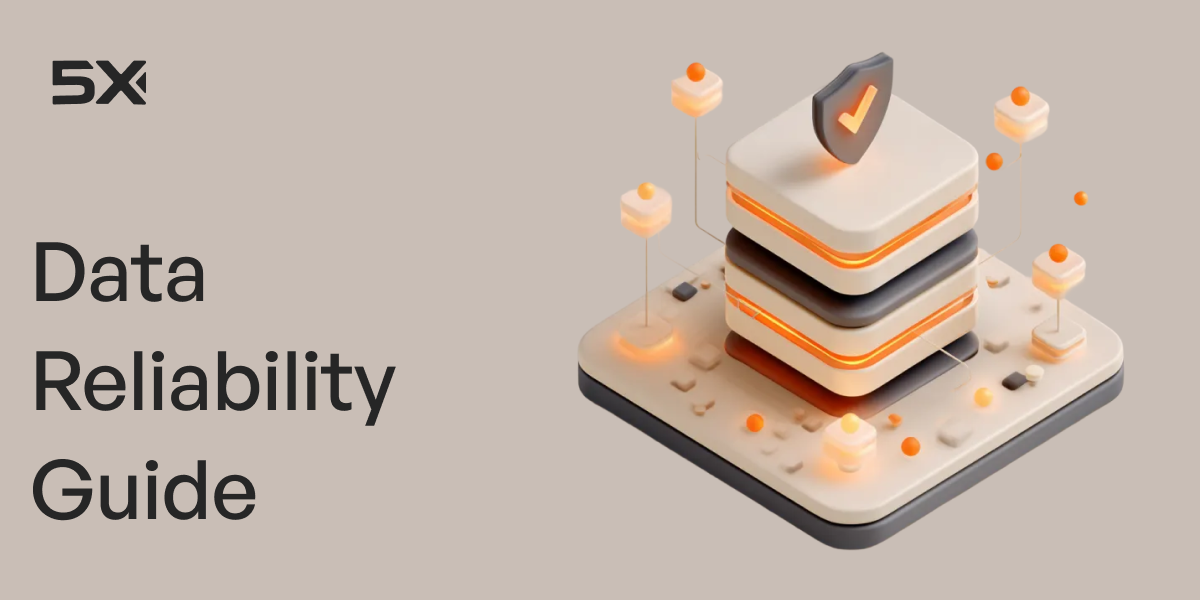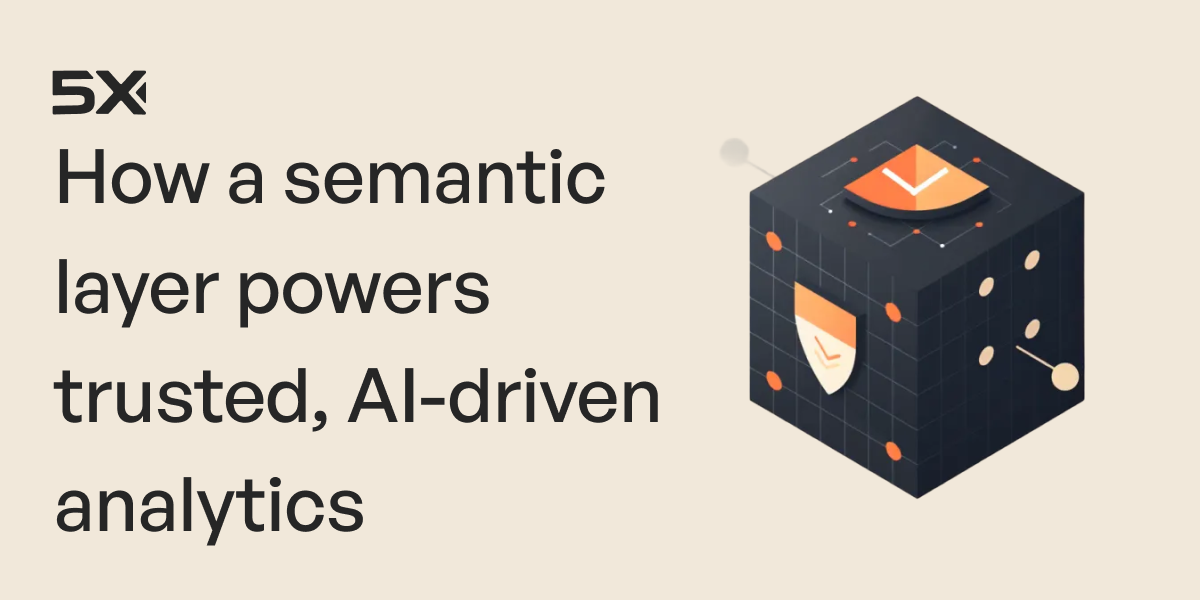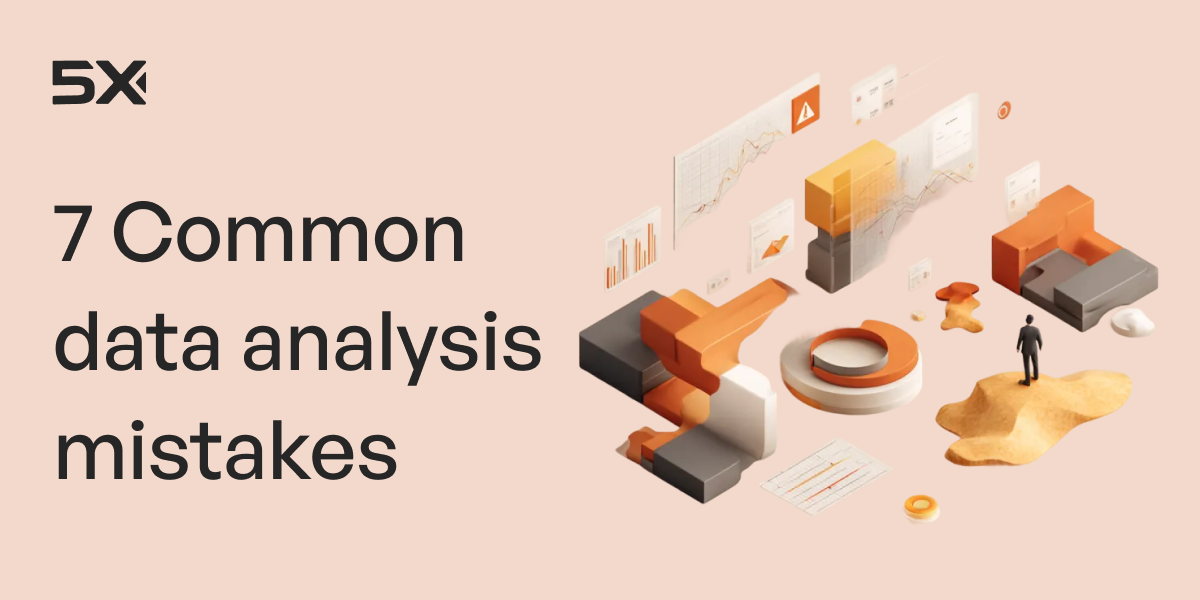How is business intelligence transforming healthcare?

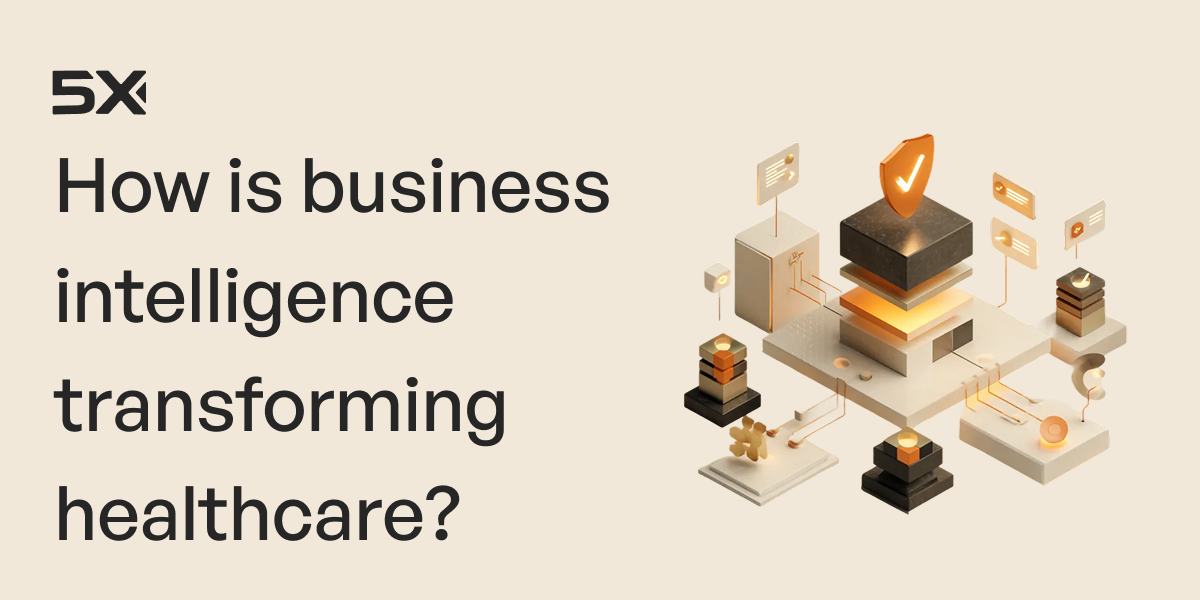

Table of Contents
TL; DR
- Healthcare BI is now essential for clinical, operational, and financial performance
- Most hospitals fail at BI due to fragmented systems, inconsistent metrics, and lack of engineering talent
- Modern BI succeeds only with a unified, governed, HIPAA-compliant data layer connecting EHR, claims, operations, and clinical data
- Leading systems like Johns Hopkins and Pfizer are proving that real-time, standardized intelligence drives measurable improvements
- 5X provides the secure, scalable, open data platform healthcare organizations need to operationalize BI without building a large data team
Modern healthcare runs on data. Every patient admission, lab result, medication, and insurance claim creates a digital footprint. Yet for years, hospitals and insurers struggled to translate this avalanche of data into better decisions.
Business intelligence (BI) is changing that by turning fragmented healthcare data into real-time, actionable insights. Healthcare BI platforms aggregate information from electronic health records (EHRs), billing systems, wearables, and more, providing a 360° view of patient care and operations.
The global healthcare BI market is growing at over 13.54% annually, as providers invest in analytics to improve outcomes. These savings come from preventing medical errors, streamlining workflows, eliminating redundant tests, and managing population health more effectively.
Across the business, people really value the insights that data can bring. Data is integral to everything we do.
~ Theivanai Palaniappan, former Head of Data at Oscar Health
How data powers Oscar Health’s mission to transform Healthcare
What makes healthcare business intelligence hard to get right
You’re not dealing with a lack of data. You’re dealing with data that’s fragmented, sensitive, and operationally disjointed. Without the right platform and structure, BI in healthcare becomes slow, unreliable, and low-impact.
1. Fragmented systems with no unified architecture
- EHRs, lab systems, billing platforms, and patient apps all speak different languages
- No central layer to harmonize these inputs means analytics becomes custom-coded guesswork
Why it matters: If you can’t connect clinical, financial, and operational data into a governed environment, you’re not doing business intelligence.
2. Regulatory overhead makes standard BI tooling ineffective
- HIPAA compliance isn’t optional, nor is PII protection, auditability, or access controls
- Traditional BI stacks require major workarounds to meet healthcare-grade governance
Why it matters: Without a compliance-first architecture, every insight becomes a risk exposure.
Also read: How we built secure, conversational BI (and why)

3. Poor data quality undermines executive confidence
- Duplicate records, inconsistent formats, undefined metrics
- Different departments show different results for the same KPIs
Why it matters: You can’t drive strategy if no one trusts the numbers on the dashboard.
4. Technical sprawl blocks scalability
- Reports pull from different systems with different structures
- Integrations are manual, brittle, and difficult to maintain
Why it matters: If it takes engineers to answer basic business questions, your BI stack can’t scale.
5. No semantic layer means no shared truth
- Every team uses its own filters, logic, and terminology
- Dashboards conflict, and leaders lose confidence in what they’re seeing
Why it matters: Without a semantic layer, “data-driven” decisions are just arguments waiting to happen.
Also read: How a semantic layer powers trusted, AI-driven analytics
6. Lack of data engineering talent stalls momentum
- Most healthcare orgs under 1,000 employees don’t have in-house data teams
- Without engineers, building and maintaining a BI environment becomes a major burden
Why it matters: Without the right foundation, you’re permanently stuck in reactive mode, chasing insights you should already have.
How 5X neutralizes these risks
- HIPAA-ready pipelines with automatic PII detection, masking, and end-to-end encryption
- Built-in semantic layer standardizes definitions and metrics across all teams
- Open-source core integrates with your current tools
- Designed for lean teams: ingest EHR, claims, lab, and operational data without needing engineers
- Governance and compliance built in from day one
5 Benefits of business intelligence for healthcare

When implemented on the right foundation, business intelligence shifts healthcare from reactive to proactive, siloed to integrated, and slow to adaptive. Here’s where it delivers meaningful value:
1. Better patient outcomes through early detection and intervention
- BI enables risk scoring, cohort analysis, and outcome tracking across populations
- Example: Predictive models flag early signs of sepsis or likely readmissions using discharge, vitals, and medication data
- Hospitals can reduce hospital-acquired infections and adverse drug events by double digits after deploying BI dashboards
- Supports evidence-based medicine by helping clinicians identify effective treatments based on historical outcomes
2. Operational efficiency and measurable cost control
- Dashboards track capacity, patient flow, and bed utilization in real time
- Bottlenecks like delayed labs or inefficient OR turnover are exposed and addressed
- Example: Hospitals may use BI to optimize supply chain and cut unused inventory waste
3. Strategic clarity and faster executive decision-making
- BI creates a “single source of truth” across clinical, financial, and operational metrics
- Executives access real-time KPIs like readmission rates, cost per case, and patient satisfaction
- Example: Self-service tools let managers explore trends without waiting on IT or data teams
Also read: Best Business Intelligence Tools For Data-Driven Decision-Making
4. Cross-functional alignment and cultural transparency
- Shared dashboards eliminate spreadsheet battles and foster interdepartmental collaboration
- Everyone—from IT to finance to care delivery—uses the same data to guide action
- Especially critical in value-based care, where interdisciplinary coordination drives outcomes
- Example: Quality improvement teams can use BI to monitor guideline adherence across sites
5. Acceleration of research, innovation, and learning cycles
- BI tools let researchers explore patterns in large datasets without weeks of prep
- Example: During COVID-19, systems with advanced BI identified key risk factors rapidly
- Public health agencies use BI for surveillance, outbreak response, and modeling
- The result: faster time-to-insight and data-driven iteration across research functions
The downstream impact on patient experience
- Coordinated data reduces repeat testing, medical errors, and communication breakdowns
- Personalized care plans, proactive follow-ups, and smarter engagement become standard
- Patient portals, AI assistants, and care recommendations all benefit from the same BI backbone
- End result: faster care, fewer surprises, better health outcomes
Build a secure, unified data foundation that enables reliable BI and AI across your entire healthcare organization.
6 Real-world use cases of business intelligence in healthcare
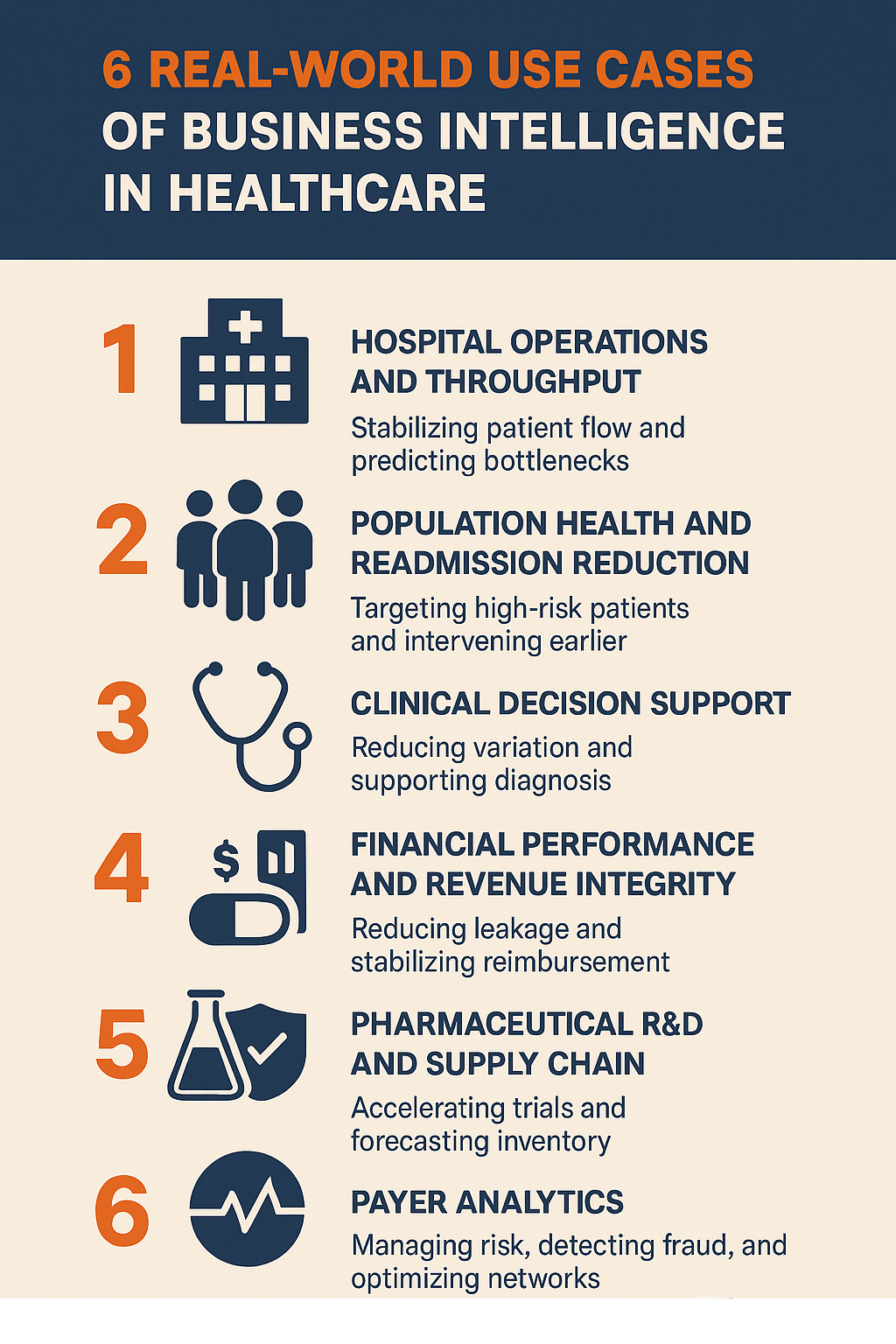
Business intelligence is not a single solution; it’s a multi-use operational capability. Healthcare organizations apply BI to improve throughput, financial performance, population health, research, and supply chains.
Below are real, verifiable examples that reflect how BI is deployed inside U.S. and global health systems today.
1. Hospital operations and throughput: Using BI to stabilize flow, predict bottlenecks, and improve reliability
Leading systems are adopting BI-driven “capacity command centers” that provide real-time situational awareness across beds, units, ED, perioperative areas, diagnostics, and discharge pathways.
What the strongest performers are doing:
- Monitoring bed occupancy, transfers, and ED congestion through real-time dashboards
- Coordinating admissions and discharges centrally with standardized analytics
- Using predictive indicators (lab turnaround times, expected discharges) to prevent bottlenecks
- Managing staffing allocation using live operational metrics
Real examples from the field:
- GE Healthcare’s Command Center deployments have documented reductions in length of stay and measurable improvements in patient flow
- Johns Hopkins, Oregon Health & Science University, Tampa General, and others publicly report stronger OR on-time starts, fewer ED boarders, and better care coordination after deploying BI-enabled command centers
- A national benchmarking survey confirms that command centers using real-time analytics improve admission–discharge–transfer (ADT) coordination and reduce operational variability
2. Population health and readmission reduction: Using BI to target high-risk patients and intervene earlier
Population health programs depend on the ability to identify risk at scale and intervene before costs escalate.
What mature health systems are doing:
- Integrating clinical, social, and utilization data to stratify risk
- Using predictive analytics to identify likely readmissions
- Directing care managers toward the patients with highest preventable risk
- Monitoring chronic-disease control at the cohort level
Real examples:
- Health Catalyst reports significant, measurable readmission reductions when organizations apply integrated analytics to risk-stratification and outreach workflows
- A JAMIA Open scoping review confirms that BI is now a core capability in evidence-based population health management
3. Clinical decision support: Applying BI to reduce variation and improve clinical reliability
Clinical leaders are using BI to reduce unwarranted variation, support diagnostic decisions, and surface risks that may not be immediately visible in the EMR.
Established use patterns:
- Evaluating current patients against large historical cohorts
- Standardizing risk scores (sepsis, falls, deterioration) embedded in clinical workflows
- Monitoring outcomes to identify gaps in clinical practice
- Using BI outputs to validate and refine care pathways
Real examples:
- Studies show BI tools help clinicians interpret patient data more reliably and support more consistent decisions across providers
- Published cases highlight improved patient outcomes when BI systems are used to guide clinicians toward earlier interventions
4. Financial performance and revenue integrity: Using BI to reduce leakage and stabilize reimbursement
Hospitals and payers are under unprecedented margin pressure. BI is increasingly the core mechanism for understanding revenue cycle inefficiencies.
What leading organizations monitor:
- Claim denials and payer-specific denial patterns
- Documentation gaps driving revenue loss
- Supply chain cost irregularities
- Variability in care delivery affecting cost of care
Reference:
- Industry overviews demonstrate that BI-driven revenue integrity efforts consistently improve financial performance and operational efficiency
5. Pharmaceutical R&D and supply chain: Using BI to accelerate trials and reduce uncertainty
Pharma companies apply BI for real-time trial oversight and supply chain optimization.
How leading pharma organizations use BI:
- Monitoring trial enrollment, dropouts, adverse events, and protocol adherence in real time
- Sharing governed data across global trial sites
- Forecasting drug inventory needs based on usage and epidemiological trends
- Analyzing real-world evidence to identify new therapeutic opportunities
Real examples:
- Pfizer publicly documented improved trial speed and data access after implementing real-time analytics pipelines
6. Payer analytics: Using BI to manage risk, detect fraud, and optimize networks
Payers operate some of the most sophisticated BI capabilities in healthcare because the financial stakes are so high.
Common uses:
- Detecting fraud, waste, and abuse
- Segmenting high-cost members and directing case management
- Evaluating provider networks based on cost and outcomes
- Supporting employer reporting and plan design
Also read: Are AI Agents the Future of Business Intelligence?
Why the future of healthcare BI belongs to organizations with the right data foundation
Healthcare is entering a phase where operational excellence, clinical reliability, and financial stability all depend on one capability: the ability to turn complex, multi-system data into trusted, real-time intelligence.
We’ve seen how BI drives earlier interventions, stronger throughput, lower readmissions, better revenue integrity, and faster research cycles. We’ve also seen why so many organizations struggle to get there: fragmented systems, inconsistent definitions, regulatory pressure, and a shortage of data engineering talent.
The systems that are winning; Johns Hopkins, OHSU, Tampa General, Pfizer, and leading payer organizations are standardizing their BI foundations.
And that is where 5X becomes essential.
5X gives healthcare leaders a modern, secure, HIPAA-ready data platform that eliminates the engineering lift holding most organizations back.
With automatic PII detection, end-to-end encryption, governed pipelines, and a built-in semantic layer, 5X replaces technical sprawl with a single, compliant environment that unifies EHR, claims, operational, and clinical data. 5X gives teams trusted metrics, consistent logic, and real-time visibility, without needing a full data engineering arm.

If you are evaluating whether BI should be a priority, the answer is simple: your organization cannot compete, innovate, or operate efficiently without it. And you cannot operationalize BI without a secure, governed, open, and scalable data foundation.
That foundation is 5X.
Modernize your BI stack and unlock secure, AI-ready analytics across your organization, talk to 5X.
FAQs
How should a healthcare organization structure its first BI team if it doesn’t have data engineers?

How long does it realistically take for a hospital to see ROI from BI modernization?

What data sources should healthcare organizations integrate first to get the most BI value?

How can CEOs ensure BI initiatives actually get adopted by clinical and operational teams?

What metrics matter most when evaluating the success of a BI program in healthcare?

Building a data platform doesn’t have to be hectic. Spending over four months and 20% dev time just to set up your data platform is ridiculous. Make 5X your data partner with faster setups, lower upfront costs, and 0% dev time. Let your data engineering team focus on actioning insights, not building infrastructure ;)
Book a free consultationHere are some next steps you can take:
- Want to see it in action? Request a free demo.
- Want more guidance on using Preset via 5X? Explore our Help Docs.
- Ready to consolidate your data pipeline? Chat with us now.
Get notified when a new article is released
Automate reliability

How retail leaders unlock hidden profits and 10% margins
Retailers are sitting on untapped profit opportunities—through pricing, inventory, and procurement. Find out how to uncover these hidden gains in our free webinar.
Save your spot






%201.svg)
